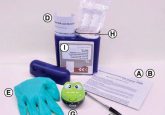Recent innovations in diagnostic development

Diagnostic method development is booming, with advances arising both from scratch and built on existing tools. Here, we highlight a few of the recent strides taken toward the optimization of diagnostic tests.
From point-of-care mass spectrometers to label-free tests that are faster and more accurate than PCR, there is no shortage of creative and effective diagnostic developments on the horizon.
DEEPSCAN for dermatology
Although traditional convolutional neural networks (CNNs) effectively diagnose some dermatological conditions, they often misdiagnose conditions that present with intricate skin lesion patterns. Because traditional imaging techniques allow for potential misdiagnoses and an increase in skin cancers has been observed in recent years, researchers are eager to develop a method capable of diagnosing even the most complex lesion patterns.
An international collaboration between researchers in India and Saudi Arabia developed a novel methodology for evaluating skin lesions using vision transformers (ViTs), models for image classification that have global contextual understanding and attention mechanisms. They compared ViTs to traditional CNNs and found that ViTs showed an 18% improvement in diagnostic accuracy compared to CNNs, displaying 97.8% accuracy when diagnosing dermatological conditions from a bank of fictional images called the Dermatological Vision Dataset.
 Three diagnostic developments bring more accessible biomarker sources to the fore
Three diagnostic developments bring more accessible biomarker sources to the fore
The detection of biomarkers has long been established as a cornerstone of diagnostics, physiological assessment and the long-term monitoring of diseases. However, for the vast majority of indications, blood has ruled supreme as the source media in which to investigate these biomarkers.
Printing point-of-care mass spectrometer components
Researchers at MIT’s Microsystems Technology Laboratories (MA, USA) have developed components of a mass spectrometer to make diagnosing and monitoring health at home a possibility. Mass spectrometry is a technique that offers precise identification of chemical components in a sample, making it an effective method for monitoring chronic illnesses. However, conventional mass spectrometers are expensive, prompting the question: how can we fit mass spectrometry’s diagnostic and monitoring power into a small, inexpensive instrument for use at home?
The ionizer component of mass spectrometers is essential for assigning charge to blood molecules to enable their analysis. Ionizers typically use electrospray, which involves firing a stream of charged particles into the mass spectrometer. Utilzing 3D printing, the team at MIT built an extremely effective, low-cost ionizer that can be mass produced and incorporated into mass spectrometers via robotic assembly methods. The team considered evaporation, voltage and circuit board design, optimizing the ionizer to operate at a voltage 24% higher than their state-of-the-art counterparts, more than doubling the signal-to-noise ratio. The ionizing device itself is only a few centimeters, yet it performs twice as well as standard ionizers.
With further development, the team hopes to combine their ionizers with previously developed 3D-printed mass filters to take them one step closer to achieving compact mass spectrometers for efficient and inexpensive diagnosis of diseases and at-home monitoring. However, before this can become reality, they also need to 3D print vacuum pumps, which has proven a major hurdle in bringing mass spectrometry in-home.
 Who won the 2024 Kavli Prize for nanoscience?
Who won the 2024 Kavli Prize for nanoscience?
Here, we present this year’s Kavli nanoscience award, shared by a trio of researchers whose work in nanoscale engineering has led to dramatic improvements in diagnostics, therapeutic delivery and bioimaging.
Simple nanopore system rivals PCR test
PCR has proved a reliable diagnostic method; however, it’s complex, requiring skilled operators to amplify viral DNA or RNA, which can take days. Additionally, these tests can only identify nucleic acids; for some diseases, it would be useful to be able to recognize other biomarkers.
To address this shortcoming of the current gold standard for COVID-19 testing, a team of researchers from the University of California–Santa Cruz (CA, USA) developed a diagnostic test that relies on microfluidics and nanopore technology to deliver amplification- and label-free diagnosis. It can diagnose SARS-CoV-2 and Zika virus in a matter of hours with high accuracy.
“We built up a simple lab-on-a-chip system that can perform testing at a miniature level with the help of microfluidics, silicon chips, and nanopore detection technologies,” commented first author Mohammad Julker Neyen Sampad. “Simple, easy, low resource tool development was our goal — and I believe we got there.”
When tested in animal trials, the new microfluidic technology correctly detected the virus for every sample that the incumbent PCR test was able to detect, including samples with low viral concentrations, even detecting viruses that the PCR tests could not. Offering high accuracy and low complexity, their system has the potential to enable faster and more accessible viral testing.
 Mutated gene is the driver of psoriasis
Mutated gene is the driver of psoriasis
What causes psoriasis? Researchers might have just found the answer.
What does AI have to say about prostate cancer?
A University of California–Los Angeles Health (CA, USA) study has demonstrated how AI can be utilized to map cancerous prostate tissue boundaries, helping clinicians accurately diagnose patients and plan treatments. This cancer contouring system was 45 times more accurate than conventional imaging and blood tests at determining the margins of the cancer. AI may also help the effectiveness of focal therapy, a minimally invasive treatment for localized tumors, by providing the therapy with clearer guidelines.
The team used biopsy data to train their AI model, Unfold-AI, to define focal therapy margins. Unfold-AI was then tested on an independent dataset, showing more accurate predication of tumor margins than conventional methods.
“Overall, the use of AI in cancer treatment could lead to more effective and personalized care for patients, with treatments that are better tailored to their individual needs and more successful in fighting the disease,” concluded study author Wayne Brisbane.





